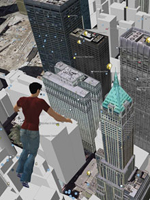Jun 24, 2007
Toward a Metaverse

In this interesting article recently published in Technology Review, Wade Roush predicts that the line between the real world and its virtual representations will soon start blurring. Here is an excerpt from the article:
[...] The first, relatively simple step toward a Second Earth, many observers predict, will be integrating Second Life's avatars, controls, and modeling tools into the Google Earth environment. Groups of users would then be able to walk, fly, or swim across Google's simulated landscapes and explore intricate 3-D representations of the world's most famous buildings ... A second alternative would be to expand the surface area of Second Life by millions of square kilometers and model the new territory on the real earth, using the same topographical data and surface imagery contained in Google Earth ... That's a much more difficult proposition ...
[W]ithin 10 to 20 years--roughly the same time it took for the Web to become what it is now--something much bigger than either of these alternatives may emerge: a true Metaverse ... It will look like the real earth, and it will support even more users than the Snow Crash cyberworld, functioning as the agora, laboratory, and gateway for almost every type of information-based pursuit. It will be accessible both in its immersive, virtual-reality form and through peepholes like the screen of your cell phone as you make your way through the real world. And like the Web today, it will become "the standard way in which we think of life online..."
While Second Life and Google Earth are commonly mentioned as likely forebears of the Metaverse, no one thinks that Linden Lab and Google will be its lone rulers. Their two systems are interesting mainly because they already have many adherents, and because they exemplify two fundamentally different streams of technology that will be essential to the Metaverse's construction...
"Google Earth itself is really neat," comments Jamais Cascio, the Metaverse Roadmap coauthor. "But Google Earth coupled with millions of sensors around the world, offering you real-time visuals, real-time atmospheric data, and so on--that's transformative."
Indeed, it's important to remember that alongside the construction of the Metaverse, a complementary and equally ambitious infrastructure project is under way. It's the wiring of the entire world, without the wires: tiny radio-connected sensor chips are being attached to everything worth monitoring, including bridges, ventilation systems, light fixtures, mousetraps, shipping pallets, battlefield equipment, even the human body ... "Augmented reality and sensor nets will blend right into virtual worlds," predicts Linden Lab's Ondrejka. "That's when the line between the real world and its virtual representations will start blurring."
23:30 Posted in Virtual worlds | Permalink | Comments (0) | Tags: virtual worlds, second life







The comments are closed.